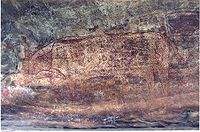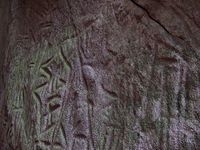- South Asian Stone Age
-
History of South Asia and India Stone age (7000–1300 BCE)- Mehrgarh Culture (7000–3300 BCE)
- Indus Valley Civilization (3300–1700 BCE)
- Early Harappan Culture (3300–2600 BCE)
- Mature Harappan Culture (2600–1900 BCE)
- Late Harappan Culture (1700–1300 BCE)
- Ochre Coloured Pottery culture (from 2000 BCE)
- Swat culture (1600–500 BCE)
Iron age (1200–26 BCE)- Vedic Civilization (2000–500 BCE)
- Black and Red ware culture (1300–1000 BCE)
- Painted Grey Ware culture (1200–600 BCE)
- Northern Black Polished Ware (700–200 BCE)
- Maha Janapadas (700–300 BCE)
- Magadha Empire (684–424 BCE)
- Nanda Empire (424–321 BCE)
- Chera Empire (300 BCE–1200 CE)
- Chola Empire (300 BCE–1279 CE)
- Pandyan Empire (300 BCE–1345 CE)
- Maurya Empire (321–184 BCE)
- Pallava Empire (250 BCE–800 CE)
- Sunga Empire (185–73 BCE)
- Kanva Empire (75–26 BCE)
- Maha-Megha-Vahana Empire (250s BCE–400s CE)
- Satavahana Empire (230–220 BCE)
- Kuninda Kingdom (200s BCE–300s CE)
- Indo-Scythian Kingdom (200 BCE–400 CE)
- Indo-Greek Kingdom (180 BCE–10 CE)
Classical period (1–1279 CE)- Indo-Parthian Kingdom (21–130s CE)
- Western Satrap Empire (35–405 CE)
- Kushan Empire (60–240 CE)
- Indo-Sassanid Kingdom (230–360 CE)
- Vakataka Empire (250s–500s CE)
- Kalabhras Empire (250–600 CE)
- Gupta Empire (280–550 CE)
- Kadamba Empire (345–525 CE)
- Western Ganga Kingdom (350–1000 CE)
- Kamarupa Kingdom (350–1100 CE)
- Vishnukundina Empire (420–624 CE)
- Maitraka Empire (475–767 CE)
- Huna Kingdom (475–576 CE)
- Rai Kingdom (489–632 CE)
- Chalukya Empire (543–753 CE)
- Shahi Empire (500s–1026 CE)
- Maukhari Empire (550s–700s CE)
- Harsha Empire (590–647 CE)
- Eastern Chalukya Kingdom (624–1075 CE)
- Gurjara Pratihara Empire (650–1036 CE)
- Pala Empire (750–1174 CE)
- Rashtrakuta Empire (753–982 CE)
- Paramara Kingdom (800–1327 CE)
- Yadava Empire (850–1334 CE)
- Solanki Kingdom (942–1244 CE)
- Western Chalukya Empire (973–1189 CE)
- Hoysala Empire (1040–1346 CE)
- Sena Empire (1070–1230 CE)
- Eastern Ganga Empire (1078–1434 CE)
- Kakatiya Kingdom (1083–1323 CE)
- Kalachuri Empire (1130–1184 CE)
Late medieval age (1206–1596 CE)- Delhi Sultanate (1206–1526 CE)
- Ahom Kingdom (1228–1826 CE)
- Reddy Kingdom (1325–1448 CE)
- Vijayanagara Empire (1336–1646 CE)
- Gajapati Kingdom (1434–1541 CE)
- Deccan Sultanates (1490–1596 CE)
Early modern period (1526–1858 CE)- Mughal Empire (1526–1858 CE)
- Maratha Empire (1674–1818 CE)
- Durrani Empire (1747–1823 CE)
- Sikh Empire (1799–1849 CE)
Regional states (1102–1947 CE)- Zamorin Kingdom (1102–1766 CE)
- Deva Kingdom (1200s–1300s CE)
- Chitradurga Kingdom (1300–1779 CE)
- Garhwal Kingdom (1358–1803 CE)
- Mysore Kingdom (1399–1947 CE)
- Keladi Kingdom (1499–1763 CE)
- Koch Kingdom (1515–1947 CE)
- Thondaiman Kingdom (1650–1948 CE)
- Madurai Kingdom (1559–1736 CE)
- Thanjavur Kingdom (1572–1918 CE)
- Marava Kingdom (1600–1750 CE)
- Sikh Confederacy (1707–1799 CE)
- Travancore Kingdom (1729–1947 CE)
Colonial period (1505–1961 CE)- Portuguese India (1510–1961 CE)
- Dutch India (1605–1825 CE)
- Danish India (1620–1869 CE)
- French India (1759–1954 CE)
- Company Raj (1757–1858 CE)
- British Raj (1858–1947 CE)
- Partition of India (1947 CE)
Kingdoms of Sri Lanka (543 BCE–1948 CE)- Kingdom of Tambapanni (543–505 BCE)
- Kingdom of Upatissa Nuwara (505–377 BCE)
- Kingdom of Anuradhapura (377 BCE–1017 CE)
- Kingdom of Ruhuna (200 CE)
- Polonnaruwa Kingdom (300–1310 CE)
- Kingdom of Dambadeniya (1220–1272 CE)
- Kingdom of Yapahuwa (1272–1293 CE)
- Kingdom of Kurunegala (1293–1341 CE)
- Kingdom of Gampola (1341–1347 CE)
- Kingdom of Raigama (1347–1415 CE)
- Kingdom of Kotte (1412–1597 CE)
- Kingdom of Sitawaka (1521–1594 CE)
- Kingdom of Kandy (1469–1815 CE)
- Portuguese Ceylon (1505–1658 CE)
- Dutch Ceylon (1656–1796 CE)
- British Ceylon (1815–1948 CE)
Nation histories- Afghanistan
- Bangladesh
- Bhutan
- India
- Maldives
- Nepal
- Pakistan
Regional histories- Assam
- Bihar
- Balochistan
- Bengal
- Himachal Pradesh
- Maharashtra
- Uttar Pradesh
- Pakistani Regions
- Punjab
- NWFP
- Orissa
- Sindh
- South India
- Tibet
The South Asian Stone Age covers the Palaeolithic, Mesolithic and Neolithic periods in South Asia. Evidence for the most ancient anatomically modern Homo sapiens in South Asia has been found in the cave sites of Batadomba lena and Beli lena in Sri Lanka.[1]In Mehrgarh, in what is today western Pakistan, the Neolithic begins ca. 7000 and lasts until 3300 BCE and the first beginnings of the Bronze Age. In South India, the Mesolithic lasts until 3000 BCE, and the Neolithic until 1400 BCE, followed by a Megalithic transitional period mostly skipping the Bronze Age. The Iron Age begins roughly simultaneously in North and South India, around 1200 to 1000 BCE (Painted Grey Ware culture, Hallur).
Contents
Homo erectus
Homo erectus lived on the Pothohar Plateau, in upper Punjab, Pakistan along the Soan River (nearby Rawalpindi) during the Pleistocene Epoch. Soanian sites are found in the Sivalik region across what are now India, Pakistan and Nepal.[2]
Biface handaxe and cleaver traditions may have originated in the middle Pleistocene.[3] The beginning of the use of Acheulian and chopper-chopping tools of lower paleolithic may be dated to approximately the middle Pleistocene.[4]
The coming of Homo sapiens
Analysis of mtDNA dates the immigration of Homo sapiens to South Asia to 70,000 to 50,000 years ago.[5] An analysis of Y chromosome haplogroups found one man in a village west of Madurai to be a direct descendant of these migrators.[6] These populations spread further to Southeast Asia, reaching Australia by 40,000 years ago. Cave sites in Sri Lanka have yielded the earliest record of modern Homo sapiens in South Asia. They were dated to 34,000 years ago. (Kennedy 2000: 180). For finds from the Belan in southern Uttar Pradesh radio carbon data have indicated an age of 18-17kya. Palaeolithic rock art is also well-known.
At the Rock Shelters of Bhimbetka humans lived throughout the Upper Paleolithic (10th to 8th millennia BC), revealing cave paintings dating to ca. 7000 BC; the Sivaliks and the Potwar (Pakistan) region also exhibit many vertebrate fossil remains and paleolithic tools. Chert, jasper and quartzite were often used by humans during this period.
Neolithic
Further information: Mehrgarh and Neolithic Tamil NaduThe aceramic Neolithic (Mehrgarh I, Baluchistan, Pakistan, also dubbed "Early Food Producing Era") lasts ca. 7000 - 5500 BC. The ceramic Neolithic lasts up to 3300 BC, blending into the Early Harappan (Chalcolithic to Early Bronze Age) period. One of the earliest Neolithic sites in India is Lahuradewa, at Middle Ganges region, C14 dated around 7th millennium BC.[7]. Recently another site near the confluence of Ganges and Yamuna rivers called Jhusi yielded a C14 dating of 7100 BC for its Neolithic levels.[8]
In South India the Neolithic began by 3000 BC and lasted until around 1400 BC.South Indian Neolithic is characterized by Ashmounds since 2500 BC in Andhra-Karnataka region, expanded later to Tamil Nadu. Comparative excavations carried out in Adichanallur in Thirunelveli District and in Northern India have provided evidence of a southward migration of the Megalithic culture[9] The earliest clear evidence of the presence of the megalithic urn burials are those dating from around 1000 BC, which have been discovered at various places in Tamil Nadu, notably at Adichanallur, 24 km from Tirunelveli, where archaeologists from the Archaeological Survey of India unearthed 12 urns with Tamil Brahmi script on them containing human skulls, skeletons and bones, plus husks, grains of rice, charred rice and Neolithic celts, giving evidence confirming it of the Neolithic period 2800 years ago. This proved that Tirunelveli area has been the abode for human habituation since the Neolithic period about 3,000 years ago. Adhichanallur has been announced as an archaeological site for further excavation and studies.[10][11]
See also
Notes
- ^ Upper pleistocene fossil hominids from Sri Lanka, Kenneth A. R. Kennedy 1, Siran U. Deraniyagala 4, William J. Roertgen, John Chiment, Todd Disotell, Section of Ecology and Systematics, Cornell University, Ithaca, New York, The Boyce Thompson Institute, Cornell University, Ithaca, New York, Department of Anthropology, Harvard University, Cambridge, Massachusetts,Archaeological Department of the Government of Sri Lanka, Colombo 7
- ^ Parth R. Chauhan. Distribution of Acheulian sites in the Siwalik region. An Overview of the Siwalik Acheulian & Reconsidering Its Chronological Relationship with the Soanian – A Theoretical Perspective.
- ^ Kennedy 2000, p. 136.
- ^ Kennedy 2000, p. 160.
- ^ James & Petraglia 2005, S6.
- ^ Spencer Wells, The Journey of Man: A Genetic Odyssey. Random House, ISBN 0-8129-7146-9
- ^ Fuller, Dorian 2006. "Agricultural Origins and Frontiers in South Asia: A Working Synthesis" in Journal of World Prehistory 20, p.42 "Ganges Neolithic"
- ^ Tewari, Rakesh et al. 2006. "Second Preliminary Report of the excavations at Lahuradewa,District Sant Kabir Nagar, UP 2002-2003-2004 & 2005-06" in Pragdhara No. 16 "Electronic Version p.28"
- ^ Sastri, Kallidaikurichi Aiyah Nilakanta. A History of South India. pp. 49–51. ISBN 0195606868.
- ^ Subramanian, T. S. (2004-05-26). "Skeletons, script found at ancient burial site in Tamil Nadu". The Hindu. http://www.hindu.com/2004/05/26/stories/2004052602871200.htm. Retrieved 2007-07-31.
- ^ Zvelebil, Kamil A. (1992). Companion Studies to the History of Tamil Literature. Brill Academic Publishers. pp. 21–22. ISBN 9004093656. "The most interesting pre-historic remains in Tamil India were discovered at Adichanallur.There is a series of urn burials. seem to be related to the megalithic complex."
References
- Kennedy, Kenneth Adrian Raine (2000). God-Apes and Fossil Men: Palaeoanthropology of South Asia. Ann Arbor: University of Michigan Press.
- James, Hannah V. A.; Petraglia, Michael D. (December 2005). "Modern Human Origins and the Evolution of Behavior in the Later Pleistocene Record of South Asia" (PDF). Current Anthropology 46 (Supplement): S3. doi:10.1086/444365. http://www.human-evol.cam.ac.uk/Members/Petraglia/pubs/JamesPetraglia(CA2005).pdf.
- Misra, V. N. (November 2001). "Prehistoric human colonization of India" (PDF). Journal of Biosciences 26 (4): 491–531. doi:10.1007/BF02704749. PMID 11779962. http://www.ias.ac.in/jbiosci/nov2001/491.pdf.
External links
Categories:- Stone Age
- Pre-Islamic heritage of Pakistan
- History of Pakistan
- Prehistoric India
Wikimedia Foundation. 2010.


